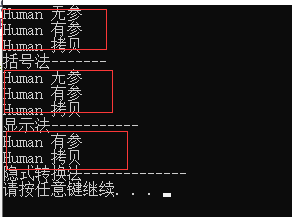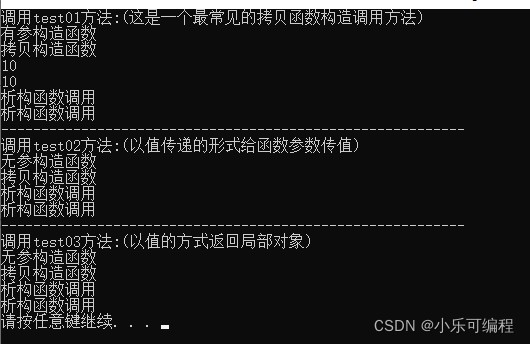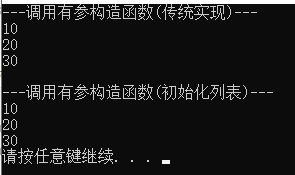C++:类与对象(更新中)
参考自身学习的学习经验与Primer c++ 第五版的定义:类的基本思想是数据抽象与封装。
说得简单一些,那就是**:对事物的往上抽象** 称为 类。
具体怎么解释呢,比如,对于我们大家而言,如果将我们抽象出来的话,那就是人。我们可以抽象成人 类。
再比如动物,比如猫,狗,猪,我们可以把他们抽象成为动物类。 正在学校学习的我们可以抽象成学生类。教师们也可以抽象成为 教师类。
1.1:类与对象的基本概念透析:
类的构成有属性、行为之分:
(初学C++对这些概念可能不太清楚,如果不仔细斟酌品味,到后面容易混乱)
属性:又被称为 数据
行为:又被称为 函数、方法
属性 与 行为 我们一般统称为 成员 ,所以又可以这样这样写:
属性, 称为: 成员属性、成员变量。
行为, 称为: 成员函数、成员方法
怎么理解属性与行为呢?
比如一个人类:Human
人,应该有他的名字,年龄等等,这些就叫做:属性。
行为呢? 吃喝拉撒 就是人的行为。
那么,啥叫 对象 ?(又称实例化)
再次举例,有了定义人类Human 以后,我们就可以实例化对象。
那么实例化我,又被称为 创建了一个 我 的对象。
然后根据类中的行为(吃喝拉撒)与属性(年龄、姓名),再次进行进一步的赋值。
比如创建了 我 这个对象以后,我名字叫张三。
然后再创建了 你 这个对象 ,你名字叫李四。
1.2:类(class)与对象在C++中代码的体现(Public):
代码如下(部分):
Class Human{
Public:
//属性:
string name;
int age;
//行为:
Void eat(){
cout<<"吃"<<endl;
};
Void drink(){
cout<<"喝"<<endl;
};
Void biubiubiu(){
cout<<"拉"<<endl;
};
Void pilipala(){
cout<<"撒"<<endl;
};
}
//以上就是类的定义 (先说一下public 先)
//然后在主函数main() 中实例化对象
int main(){
Human Zhangsan //创建了一个类名是Human 的对象 Zhangsan
Human Lisi // 又可以理解就在Human类下实例化了一个lisi的对象。
//给Zhangsan赋名、年龄
Zhangsan.name="张三";
Zhangsan.age=18;
//李四:
Lisi.name="李四";
Lisi.age=19;
//张三要吃 那就在shell(控制台屏幕显示)中体现出来: 调用成员函数
cout<<Zhangsan.eat()<<endl;
}
1.3:访问权限
类在设计的时候, 成员属性与成员函数可以放在不同的权限下,用于控制:
①public:公共权限
②protected:保护权限
③private:私有权限
区别:
public:成员 类内可以访问,类外可以访问
protected:成员 类内可以访问,类外不可访问 子类可以访问
private:成员 类内可以访问,类外不可访问 子类不可以访问
代码如下:
#include<iostream>
#include<string>
#include<Windows.h>
using namespace std;
class Human{
public:
string house;//房子
protected:
int money; //钱
void fun_pro();
private:
int bank_password; //银行卡密码
void fun_pri();
public:
//类内可以访问:
void test1(){
string house="别墅";
int money=888;
int bank_password=123;
}
};
int main(void){
Human son;
son.house="海景房";
//son.money=8888; 保护权限类外不可访问
//son.bank_password=321;私有权限类外不可访问
son.test1();
//son.fun_pro();
//son.fun_pri();
//从以上代码可以知道,无论是成员变量也好,成员方法也好,都是有权限的.注释是属于类外访问,是非法的.
system("pause");
return 0;
}
1.4:结构体struct 与 类class的区别:
其实是一样的,只是有一点区别,那就是在默认的权限不一样.
struct:默认权限是公有
class:默认权限是私有
class Human{
int name; //属于私有权限private
};
struct Human{
int name;//属于公共权限public
};
1.5:成员属性设为私有的意义
优点1:可以自己控制读写权限(按需定义读写)
优点2:对于写权限,可以检测数据的有效性
代码如下:(部分 代码是从文档写下来然后拷贝过来的,应该有些错误 但不影响)
Class Human{
Private:
String h_name; //设置可读可写
Int h_age;//设置可读不可写
String h_lover //设置可写不可读
//以上的设置在public中体现:
Public:
String getName(){
return h_name;
}
Void setName(string name){
h_name=name;
}
Int getAge(){
Return h_age
}
Void setLover(strng lover){
h_lover=lover
}
}
//以上就是成员属性设置私有的第一个优点,可以按需定义读写方法.
//检测数据的有限性如何体现呢?比如我们在public方法中再次定义一个成员方法,将age设置为可读可写的,即再多加一个setAge()方法即可:
Public: //在前面写了public 后面仍然可写
Void setAge(int age){
If(age<0 ||age>150){
Return;
}
h_age=age;
};
1.6:构造函数与析构函数
构造函数:
1.没有返回值 不需要void;
2.函数名与类名一致;
3.形式:有参\无参\重载
4.创建对象时,会自动调用且只调用一次.
析构函数:
1.进行堆区清理操作
2.无返回值 不需要void
3.函数名与类型相同 只需要前面加上:~
4.不能够带参,不可以重载
5.对象销毁前会自动调用析构函数,只调用一次.
#include<iostream>
#include<string>
#include<Windows.h>
using namespace std;
class Human{
public:
//无参构造函数
Human(){
cout<<"无参构造函数的调用"<<endl;
}
//有参构造函数
Human(int a){
age=a;
cout<<"有参构造函数的调用"<<endl;
}
//析构函数
~Human(){
cout<<"析构!"<<endl;
};
public:
int age;
};
//无参构造调用
void test01(){
Human wucan;
};
void test02(){
Human youcan(10);
cout<<youcan.age<<endl;
};
int main(void){
test01; //无参构造不需要加()
test02();
system("pause");
return 0;
}
1.7:构造函数的分类:
构造函数的分类:
①按参数分: 有参构造 无参构造
②按类型分: 普通构造 拷贝构造
构造函数的调用方式:
①括号法
②显示法
③隐式转换发
无参与有参(代码与上面类似 为了容易区分 分多个区域写):
#include<iostream>
#include<string>
#include<Windows.h>
using namespace std;
//构造函数的分类:
// ①按参数分: 有参构造 无参构造
// ②按类型分: 普通构造 拷贝构造
//
//构造函数的调用方式:
// ①括号法
// ②显示法
// ③隐式转换发
//①按参数分: 有参构造 无参构造
class Human{
public:
Human(){
cout<<"Human 无参"<<endl;
}
Human(int a){
age=a;
cout<<"Human 有参"<<endl;
}
private:
int age;
};
void test01(){
Human a;
};
void test02(){
Human b(10);
}
int main(void){
test01;
test02();
system("pause");
return 0;
}
拷贝构造函数: 顾名思义 就是用于复制(拷贝)一个对象 的函数
#include<iostream>
#include<string>
#include<Windows.h>
using namespace std;
//构造函数的分类:
// ①按参数分: 有参构造 无参构造
// ②按类型分: 普通构造 拷贝构造
//构造函数的调用方式:
// ①括号法
// ②显示法
// ③隐式转换发
//②按类型分: 普通构造 拷贝构造
class Human{
public:
//有参构造(无参\有参都属于普通构造)
Human(int a){
age=a;
cout<<"Human 有参"<<endl;
}
//拷贝构造函数:就是拷贝一个完全一样的对象
//const是常量.
//const是为了防止让本体发生改变,其次还要按照引用的方式传进来
//形参son命名随便写都可以
Human(const Human &son){
age=son.age;
cout<<"Human 拷贝"<<endl;
}
public:
int age;
};
//测试方法
void test03(){
Human b(10); //有参构造函数 年龄为10的b
Human son(b);//拷贝构造函数(其实我觉得叫拷贝对象构造函数更贴切) 意思是:从对象b中拷贝一个age值相同的名为son的对象出来.
cout<<b.age<<endl;
cout<<son.age<<endl; //值与这个b是一样.
}
int main(void){
test03();
system("pause");
return 0;
}
构造函数调用方法: 随便你用哪个都行 看你喜欢
#include<iostream>
#include<string>
#include<Windows.h>
using namespace std;
//构造函数的分类:
// ①按参数分: 有参构造 无参构造
// ②按类型分: 普通构造 拷贝构造
//构造函数的调用方式:
// ①括号法
// ②显示法
// ③隐式转换发
class Human{
public:
Human(){
cout<<"Human 无参"<<endl;
}
Human(int a){
age=a;
cout<<"Human 有参"<<endl;
}
Human(const Human &son){
age=son.age;
cout<<"Human 拷贝"<<endl;
}
private:
int age;
};
//括号法
void test_1(){
Human a;
Human b(10);
Human c(b);
cout<<"括号法-------"<<endl;
}
//显示法
void test_2(){
Human aa;
Human bb=Human(100);
Human cc=Human(bb);
cout<<"显示法-----------"<<endl;
}
void test_3(){
Human bbb=1000; //有参构造 等同于 Human bbb=Human(10);
Human ccc=bbb; //拷贝构造 等同于 Human ccc=Human(bbb);
cout<<"隐式转换法-------------"<<endl;
}
int main(void){
test_1();
test_2();
test_3();
system("pause");
return 0;
}
运行图:
1.8: 拷贝构造函数的调用时机
题目理解起来可能有些模糊.
意思就是:
编译器会在什么时候调用 拷贝构造函数
时机①:使用已有的对象用来初始化新的对象
时机②:以值传递的形式给函数参数传值
时机③:以值的方式返回局部对象
时机④ 对象数组的初始化列表中,使用对象
代码如下: 有注释 应该不会看懵
#include<iostream>
#include<string>
#include<Windows.h>
using namespace std;
class Human{
public:
int age;
Human(){
cout<<"无参构造函数"<<endl;
}
Human(int a){
age=a;
cout<<"有参构造函数"<<endl;
}
Human (const Human &son){
age=son.age;
cout<<"拷贝构造函数"<<endl;
}
~Human(){
cout<<"析构函数调用"<<endl;
};
};
//时机①:使用已有的对象用来初始化新的对象
/*说明:调用拷贝构造函数规则:调用函数时,实参是对象,形参不是引用类型的时候会调用拷贝构造函数;
如果函数的形参是引用类型,就不会调用拷贝构造函数*/
void test01(){
Human p1(10); //调用有参构造函数 传10进去
Human p2(p1);//调用拷贝构造函数
//测试是否拷贝成功
cout<<p1.age<<endl;
cout<<p2.age<<endl;
}
//时机②:以值传递的形式给函数参数传值 (值传递的本质是会创建一个临时的副本出来,这个临时的调用完会消失)
//调用这个方法的作用就是为了让大家清晰地了解到:当 实参q1传给形参x的时候,会调用一个拷贝构造函数
void demo2(Human x){
}
void test02(){
Human q1; //创建对象q1;
demo2(q1);
}
//时机③:以值的方式返回局部对象
Human demo3(){
Human a1; //创建一个局部对象 //调用默认构造函数
return a1; //这个一个值的对象 不会返回 Human a1 这个对象 ,他会拷贝一个新的对象出来,返回到调用它的函数
}
void test03(){
Human a = demo3(); //human a 对象来接收demo3() 的数据
}
//④ 对象数组的初始化列表中,使用对象 也会调用默认构造函数
//不多作解释 知道就好:
// Human f1,f2,f3,f4 创建了4个对象 流星花园F4
// Human cosplay_f4[4]={f1,f2,f3,f4} //定义了一个数组
//初始化使用了对象.(理解为有4个精神精神小伙cos流星花园)但此时但会调用4个拷贝构造函数.
int main(void){
cout<<"调用test01方法:(这是一个最常见的拷贝函数构造调用方法)"<<endl;
test01();
cout<<"----------------------------------------------------------"<<endl;
cout<<"调用test02方法:(以值传递的形式给函数参数传值)"<<endl;
test02();
cout<<"----------------------------------------------------------"<<endl;
cout<<"调用test03方法:(以值的方式返回局部对象)"<<endl;
test03();
system("pause");
return 0;
}
代码实现图:
1.9: 构造函数调用规则:
默认情况下,C++编译器至少会给一个类添加3个构造函数:
①默认构造函数(无参的,函数体为空的)
②默认析构函数(无参的,函数体为空的)
③默认拷贝构造函数,对属性进行值的拷贝.
规则:
①如果定义了有参构造函数,C++不会提供无参构造函数,但是会提供默认构造函数.
②如果定义了拷贝构造函数,C++不会提供其他构造函数了(包括默认构造\默认析构函数\默认拷贝构造函数)
可以理解为:你去一家面馆吃饭,你跟老板说来碗热面. (你没有提要求),老板就会给你热面放香菜进去. 但是如果你提了要求,说来碗热面不要香菜,那老板就不会给你放香菜.
1.10: 浅拷贝与深拷贝:
浅拷贝:简单的赋值拷贝,带来了问题就是 堆区内存的重复释放
深拷贝:在堆区重新new空间,进行拷贝赋值.
伪代码:
Human a1; //创建对象
human a2(a1);//会调用一个拷贝构造函数
假设我们在前面给a1这个对象new了一块空间:
int *arrd;
对象a1的这个成员会指向一个地址为:0x0001的堆区
拷贝出来一个a2的时候 ,浅拷贝就是一个完全的赋值拷贝,
对象a2的arrd成员也会指向地址为:0x0001的堆区;
我们知道析构函数会清理操作,
假设析构函数被调用进行清理的时候
那么就会 重复清理某一个堆区(这是非法的)
所以就需要在实现拷贝构造函数的时候,需要自己定义:
Human(const Human &son){
arrd=new int(*son.addr);//意思就是为调用拷贝构造函数的那个对象给它重新创建一个堆区.
}
如果你不为它重新创建一个堆区,系统会默认调用这个代码:
addr=son.addr;
//这是一个简单的赋值操作,这会让son.addr与a1.addr共同享有一个堆区.(这是不明智的)
2.1: 初始化列表:
初始化列表:
作用:初始化属性
语法:构造函数():属性1(value1),属性2(value2)…{};
#include<iostream>
#include<string>
#include<Windows.h>
using namespace std;
//一般的初始化操作:
class Human{
public:
int p_a;
int p_b;
int p_c;
Human(int a,int b,int c){
p_a=a;
p_b=b;
p_c=c;
}
};
//初始化列表:
class Super{
public:
int m_a;
int m_b;
int m_c;
//不带参:Super():m_a(10),m_b(20),m_c(30){};
Super(int a,int b,int c):m_a(a),m_b(b),m_c(c){};
};
void test01(){
Human s1(10,20,30);//调用有参构造
cout<<"---调用有参构造函数(传统调用)---"<<endl;
cout<<s1.p_a<<endl;
cout<<s1.p_b<<endl;
cout<<s1.p_c<<endl;
cout<<endl;
}
void test02(){
Super s2(10,20,30);
cout<<"---调用有参构造函数(初始化列表)---"<<endl;
cout<<s2.m_a<<endl;
cout<<s2.m_b<<endl;
cout<<s2.m_c<<endl;
}
int main(void){
test01();
test02();
system("pause");
return 0;
}
实现图:



